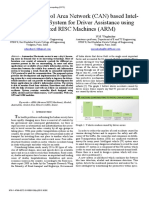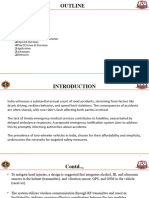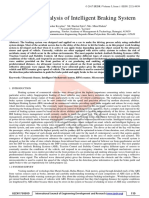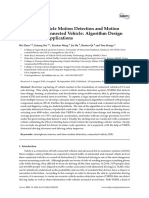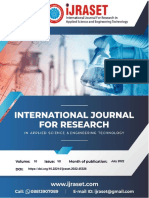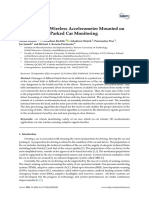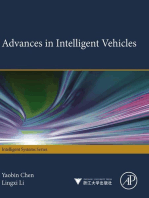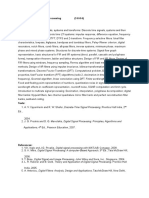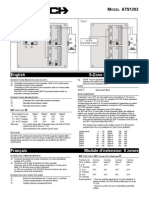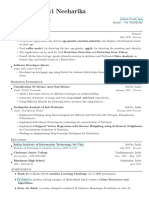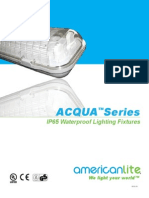Professional Documents
Culture Documents
Collision Avoidance Systems For Vehicle Safety Using Ultrasonic Distance Sensing Eye Blink Sensor and Alcohol Detector
Collision Avoidance Systems For Vehicle Safety Using Ultrasonic Distance Sensing Eye Blink Sensor and Alcohol Detector
Original Title
Copyright
Available Formats
Share this document
Did you find this document useful?
Is this content inappropriate?
Report this DocumentCopyright:
Available Formats
Collision Avoidance Systems For Vehicle Safety Using Ultrasonic Distance Sensing Eye Blink Sensor and Alcohol Detector
Collision Avoidance Systems For Vehicle Safety Using Ultrasonic Distance Sensing Eye Blink Sensor and Alcohol Detector
Copyright:
Available Formats
Volume 9, Issue 4, April – 2024 International Journal of Innovative Science and Research Technology
ISSN No:-2456-2165 https://doi.org/10.38124/ijisrt/IJISRT24APR1634
Collision Avoidance Systems for Vehicle Safety
Using Ultrasonic Distance Sensing Eye Blink
Sensor and Alcohol Detector
Soumya Mazumdar1(0009-0006-3521-9557); Shivam Chowdhury2; Souravdeep Giri3; Adrita Bhattacharya4
1
Indian Institute of Technology Madras, Tamil Nadu, India
1,2,3,4
Gargi Memorial Institute of Technology [JIS Group], West Bengal, India
Coresponding Author:- Soumya Mazumdar1
Abstract:- Car wrecks are increasingly seen as a major integrate multiple sensors capable of detecting potential
safety issue; damage and fatality reports from these hazards and alerting drivers in real-time [3, 4].
collisions are frequent. There are also more pedestrians Key Components of our Proposed Collision Avoidance
who are killed by automobile accidents in cities and on System Include:
highways. Additionally, autonomous cars often kill wild
creatures that go farther into nature reserves. One Ultrasonic Distance Sensor: Enables automatic braking
cannot put a figure on the cost of a life, yet auto and collision avoidance by detecting obstacles and
accidents hurt assets. This study looks at the creation calculating safe distances between vehicles.
and use of a complete collision avoidance system with the Eye Blink Sensor: Designed to monitor driver fatigue by
goal of improving vehicle safety by using cutting-edge detecting eye blinks, a common indicator of drowsiness.
technology. The suggested system includes an alcohol Alcohol Detector: Utilizes an alcohol sensor (MQ-3)
detector to stop accidents caused by intoxicated driving, interfaced with Arduino to assess driver sobriety and
an eye blink sensor to identify driver weariness, and an prevent accidents caused by impaired driving.
ultrasonic distance sensor to enable automated braking
and collision avoidance. These sensors are seamlessly Conventional vehicle safety technologies often focus
integrated to identify possible traffic dangers and initiate on luxury vehicles equipped with sophisticated monitoring
necessary reactions, all without depending on driver systems, such as speed sensors and anti-lock brakes, which
participation, thanks to the use of Arduino may not be universally accessible due to cost constraints [3,
microcontrollers. The system design, methodology, and 4]. Our research aims to develop a cost-effective yet
experimental findings are discussed in the study, which efficient collision avoidance system that can be widely
also shows how successful this integrated approach is at adopted to enhance safety for all vehicle users.
reducing road accidents. This study advances the global
objective of increasing road safety by democratizing The proposed system will leverage these sensor
access to cutting-edge safety features that were technologies to detect potential dangers on the road and
previously only available in expensive cars. trigger appropriate responses, such as automatic braking,
without relying solely on driver intervention. By integrating
Keywords:- Alcohol Detector, Arduino Microcontroller, these functionalities into an Arduino-based platform, we aim
Collision Avoidance System, Driver Fatigue Detection, Eye to democratize access to advanced safety features previously
Blink Sensor, Road Safety, Ultrasonic Distance Sensor, limited to high-end vehicles.
Vehicle Safety.
This paper presents the design and implementation of
I. INTRODUCTION an automatic microcontroller-based collision avoidance
system that utilizes obstacle detection and distance
Road traffic accidents pose a significant global measurement to ensure safe driving practices, utilizing an
challenge, contributing to a staggering number of fatalities alcohol sensor (MQ-3) interfaced with Arduino to assess
annually and resulting in substantial economic losses, driver sobriety and prevent accidents caused by impaired
particularly in low and middle-income countries [1]. The driving and eye blink sensor designed to monitor driver
urgency to address this issue is underscored by the need for fatigue by detecting eye blinks, a common indicator of
effective road safety measures that can mitigate the impact drowsiness. . The subsequent sections will delve into related
of preventable accidents [2]. works, system design and implementation, experimental
results, and concluding insights drawn from this study.
The implementation of collision avoidance systems
represents a promising avenue for enhancing vehicle safety
and reducing accident rates. These systems leverage
advanced technologies, such as Arduino microcontrollers, to
IJISRT24APR1634 www.ijisrt.com 684
Volume 9, Issue 4, April – 2024 International Journal of Innovative Science and Research Technology
ISSN No:-2456-2165 https://doi.org/10.38124/ijisrt/IJISRT24APR1634
II. LITERATURE REVIEW In the papers, diverse approaches to alcohol detection
and vehicle safety systems are also explored. Simplifies an
The evolution of collision avoidance systems in existing alcohol detection system by integrating real-time
vehicle safety has progressed from basic electronic circuits message-based confirmation and linking vehicle ignition
to sophisticated intelligent systems incorporating distance control to alcohol checking [19]. The system comprises
and camera sensors [5]. Previous approaches have explored three main components: an alcohol sensor that detects
various technologies such as range sensors for obstacle alcohol by breath, a controlling unit that processes sensor
detection [6], laser beams for position estimation [5], and output to control DC motors and indicate status, and a motor
automation of acceleration and braking to reduce rear-end driver shield to manage motor control. Incorporates wireless
collisions in heavy traffic [7]. However, these methods often and cloud technologies for automatic ignition cutoff upon
have limitations, such as high cost, reliance on specific detecting alcohol consumption using an alcohol sensor.
traffic conditions, or restricted countermeasure capabilities Additionally, an IR sensor is utilized to check seat belt
[10, 11, 12]. Other approaches utilize radar detectors [9], usage [20]. Integrates GPS interfacing and signal
digital imaging, and artificial intelligence for steering and enhancement for long-distance sensor connections. The
collision detection in specific vehicle types [10]. These system uses sensors to detect seat belt status, and a
systems, while innovative, may be limited by development board processes sensor outputs to control
implementation challenges such as software complexity and vehicle ignition via a relay. Introduces an automatic vehicle
sensor integrity [13, 14]. Overall, the pursuit of effective speed control system using a proximity sensor to detect
collision avoidance systems remains complex, with ongoing nearby objects and adjust vehicle speed accordingly. These
challenges related to system cost, sensor reliability, and studies collectively contribute to advancements in vehicle
practical implementation [13, 14]. safety technologies, particularly in alcohol detection and
driver behavior monitoring [21].
Driver drowsiness detection systems employ various
technologies to monitor and analyze the condition of drivers III. SYSTEM ARCHITECTURE
in real-time [13]. Video-based approaches use artificial
intelligence and visual data to track and assess driver A. For Ultrasonic Distance Sensor
fatigue, utilizing methods like band power analysis and
Empirical Mode Decomposition, with SVM for When Designing the System the Following Presumptions
classification [14]. Bayesian networks are applied to extract are Made.
driver-vehicle interaction features, enhancing the accuracy
of drowsiness detection [15]. EEG and EOG channels are A four-wheeled vehicle is said to
utilized for brain and visual activity monitoring, integrating All four wheels get braking torque.
diagnostic techniques and fuzzy logic for detection based on The brake dynamics are regarded as a linear first-order
blinking and EEG signals [16]. Image processing and system; the effect of the suspension on the tire axels is
pattern classification techniques, such as Active Appearance discounted; vertical, roll, and pitch motion are
Model (AAM) and K-Nearest-Neighbor, enable facial disregarded;
feature tracking and sleepiness level categorization [17].
Viola-Jones algorithm is used for head posture estimation, The Vehicle Model's Design also Takes into Account the
enhancing real-time detection robustness [18]. Machine Following Factors
learning approaches, leveraging facial action data, including
eye blink and yawning, are deployed to identify driver The car's lateral velocity, or speed, expressed in v m/s
drowsiness effectively [8]. These systems contribute to road Vehicle mass (kg)
safety by alerting drivers and potentially preventing
Wheel radius (R m)
accidents caused by drowsy driving.
Wheel angular velocity (ω rad/s)
Fig 1: Vehicle Obstacle Avoidance Model in Cartesian form
IJISRT24APR1634 www.ijisrt.com 685
Volume 9, Issue 4, April – 2024 International Journal of Innovative Science and Research Technology
ISSN No:-2456-2165 https://doi.org/10.38124/ijisrt/IJISRT24APR1634
From Fig. 1, vehicle dynamics are driven. A position The pace at which the vehicle position changes is
vector with the following values may be used to indicate the described by the kinematic equations (Equations 4 and 5)
vehicle's starting location: below.
𝑇
𝑦𝑖𝑡𝑎𝑛𝜃
𝑃𝑖 (𝑡) = [𝑦𝑖 𝑡𝑎𝑛𝜃 𝑇𝑑2 − 𝑦𝑖2 𝑡𝑎𝑛2 𝜃𝑡𝑎𝑛−1 ( ) ] (1) 𝑑
𝑑𝑥 𝑐𝑜𝑠𝜃 0
𝑦𝑖 𝑑𝑡 𝑠𝑖𝑛𝜃 0 𝜐]
𝑃𝑖 (𝑡) = 𝑑𝑦 =[ 1 ][ 𝜔 (4)
𝑑𝑡 0
𝑑𝑡
Where x, y, and θ represent the vehicle's angular tilt, [ 𝑑𝜃
𝑑𝑡 ]
vertical displacement, and horizontal displacement,
respectively. The formula for calculating the distance Where
between a vehicle and an obstacle is Td = Ts + Ta, where Ts
𝑅 𝑅
and Ta stand for target stoppage distance and avoidance 𝜐] 2 2 𝜔𝑙
range, respectively. It is possible to represent the Braking [ 𝜔 =[ 𝑅 𝑅 ][ 𝜔𝑟 ] (5)
−
𝑙𝜔 𝑙𝜔
force, FB(𝑇𝑑 , 𝜔, 𝜐), as (2):
𝑑2
Furthermore, lw is the separation between the two
𝑚 [ 𝑑𝑡 𝑃𝑖 (𝑡)] − 𝐹𝑝𝑖 (𝑡) = 0 (2) wheels, R is the wheel's radius, ωl is the left wheel's angular
velocity, and ωr is the right wheel's angular velocity.
Where
𝑑
(0< 𝑃𝑖(𝑡))
Using Maplesim to Implement
−𝐹𝐵 (𝑇𝑑 ,𝜔,𝜐) 𝑑𝑡
𝐹𝑝𝑖 (𝑡) = {0 (3) The Maplesim simulation environment is used to
𝑂𝑡ℎ𝑒𝑟𝑤𝑖𝑠𝑒
initially develop the system. The selected simulation model
in Maplesim is shown in Fig. 2.
and the torque component at the starting location is
represented by Fpi(t).
Fig 2: Model of Vehicle Braking
Using a Proto Type The sound signal is converted by the ultrasonic sensor
The Arduino Uno microcontroller board is interfaced into an electrical signal, which is then analyzed by a
with an ultrasonic module in the system. For the project, an microprocessor to determine the distance. The speed of
ultrasonic transducer made up of a transmitter and receiver sound is taken into account when calculating the overall
is used. amount of time required to transmit and receive waves.
After that, a microcontroller software calculates the
The Ultrasonic sensor receives a trigger pulse from the distance. The distance that was measured may be used by
Arduino Uno and broadcasts ultrasonic waves in response. the user as a control parameter to initiate automated control
The transducer receives the sent waves once again after they outputs and to provide an audio-visual warning for
are reflected back from the object. The Arduino Uno automated braking and deceleration based on the threshold
receives an echo pulse from an ultrasonic sensor. values set in accordance with the software shown in figure 3
as the block diagram.
IJISRT24APR1634 www.ijisrt.com 686
Volume 9, Issue 4, April – 2024 International Journal of Innovative Science and Research Technology
ISSN No:-2456-2165 https://doi.org/10.38124/ijisrt/IJISRT24APR1634
Fig 3: System Block Diagram of Ultrasonic Range Sensors
The general block diagram includes the following B. For Eye Blink Sensor
components: sensors and other output devices; range sensing As seen in Figure 4, the system block diagram consists
unit (forward and reverse ultrasonic range sensors) for of the following components: Power supply, buzzer, LED
measuring distance; warning unit (blinker, LCD, and LED Arduino (UNO), relay module, DC, and eye blink (IR),
displays to alert drivers or other road users); and braking which is connected to sleep detection and alerts the driver.
unit for applying brakes. The power supply unit is a DC The primary element is the Arduino Uno, a Microcontroller
battery that can supply up to 12V, and the circuit uses up to (MC) based on ATmega328 that handles all tasks associated
7–12V to supply 5V DC to the microcontroller. Fig. 4 with managing the embedded system circuit. The blinking
displays the system's flow chart. module operates by first applying infrared light to the eye
region, and then using an image transistor and a separation
Using the Proteus program, the different components' circuit to detect variations in the dispersed light.
circuit pin connections are built. Figure 5 displays the
schematic diagram.
Fig 4: Schematic Block Diagram of Eye Blinking Sensor
The eye twitch sensor, which senses the driver's once the engine is started. The flow diagram shown in
slumber, is the system's main working mechanism. The Figure 5 illustrates the procedure. The sensor output on this
buzzer is given this effect. When the driver is asleep, the device is provided for comparison with the Arduino. When
rotation speed decreases, but the wheel is stopped by the the buzzer vibrates automatically and the value goes above
blink sensor's receipt of the sensor's signal. This app the limit, the LED illuminates, the vehicle immediately
provides a fresh approach to preventing sleepy males. The stops and utilizes GPS to find the car's real location in terms
apparatus has an installed blink sensor. The sensors of latitude and longitude.
automatically assess the driver's breath and detect eye blinks
IJISRT24APR1634 www.ijisrt.com 687
Volume 9, Issue 4, April – 2024 International Journal of Innovative Science and Research Technology
ISSN No:-2456-2165 https://doi.org/10.38124/ijisrt/IJISRT24APR1634
Steps in the Implementation Procedure:
As shown in Figure 6, connect the eye Blink sensor to
Arduino pin D0.
Attach the buzzer to pin D13 on the Arduino.
Methodical Execution Steps:
Attach the DC motor to the relay, then connect the
relay to pin A0 on the Arduino. Now use a USB cord to
dump the code into Arduino. After connecting the USB cord
to the PC, launch the Arduino software, input the code,
compile it, and execute it. Next, choose the Arduino port
and click the upload button, which will upload your code to
the Arduino. Connect the batteries now, then observe the
eye blink sensor's output. An eyeblink lasting more than two
seconds will cause the car's engine to stop. Figure 6
provides a detailed illustration of the planned work.
Fig 5: Flow Diagram of Eye Blinking Sensor
Fig 6: Final Connection of the Block for Eye Blinking Sensor
C. For Alcohol Detection threshold. The output of the driver indicates its state. The
Figure 7 shows the block diagram of the parts that buzzer activates, the red light LED begins to shine, and a
make up the driver's alcohol detecting system. The main part message is sent to the selected recipient when the driver is
that regulates the model's general operations is the Arduino found to be operating their vehicle recklessly. The main
UNO. The driver will get an analog signal and the sensor's purpose of the relay is to cut off the engine's power supply
green LED will flash if the driver has consumed alcohol in the event that the driver is discovered to be inattentive.
because the alcohol sensor measures alcohol based on First, the alcohol sensor measures the driver's blood alcohol
human breath. content as soon as they get in and start the engine. If the
driver's blood alcohol content is higher than the threshold, a
The alcohol sensor will record both digital and relay immediately cuts off the car's power supply,
analogue measures; however, we will utilize the analogue preventing the driver from starting the engine. The car's
readings because we need to set a threshold. This research engine starts and moves forward if the MQ-3 sensor first
proposes a real-time driver monitoring system to measure finds no alcohol content. The driver receives a buzzer
alcohol consumption. The brains behind the whole idea are warning if, after starting the car, it is found that there is any
the Arduino UNO, which powers every aspect of the system. alcohol present. The car gradually reduces its speed until it
Using digital data from an external ADC, the Arduino UNO stops entirely.
evaluates if the alcohol concentration is above or below the
IJISRT24APR1634 www.ijisrt.com 688
Volume 9, Issue 4, April – 2024 International Journal of Innovative Science and Research Technology
ISSN No:-2456-2165 https://doi.org/10.38124/ijisrt/IJISRT24APR1634
When this process occurs, the message alert is sent to As shown in figure. 8, the project's block diagram
the authorized user using the Twilio application. To inform makes it evident how the project operates. In the stated
the authorized user of the driver's current status, this is done. method, the car's ignition is turned on first by the driver or
anybody else attempting to start it, and then the alcohol
sensor, or MQ3, measures the amount of alcohol in the
vehicle. When an automobile's alcohol content is below the
threshold amount that the owner or someone responsible for
maintaining safety has established, the car starts
continuously. If the car's alcohol threshold is exceeded, a
buzzer will first sound, followed by a beep, and then a red
led will shine for a while. This is the only functional
component of the opposite hand GSM apparatus. We can
send the owner an SMS using the system, and we also
utilize GPS to find the car's real location in terms of latitude
and longitude.
Fig 7: Diagram Showing the Position of the Vehicle's
Alcohol Sensor
Fig 8: Working Alcohol Detection Sensor Flowchart
IV. RESULTS AND DISCUSSION ultrasonic distance sensor proved invaluable in identifying
possible crash situations.
The study highlights the effectiveness of an integrated
collision avoidance system that makes use of cutting-edge Promising results were obtained from the performance
sensor technology with the help of convincing experimental assessment of each sensor in the combined system. The eye
findings and analysis. The eye blink sensor's capacity to blink sensor was able to detect driver tiredness, which is
precisely identify driver exhaustion by tracking eye blinks— important since it allows automated intervention and
a crucial sign of drowsiness—was shown throughout the preemptive alarm systems to avert accidents. In a similar
experimental assessment. In a similar vein, the alcohol vein, the alcohol detector demonstrated excellent sensitivity
detector that interfaced with Arduino showed strong in identifying alcohol concentrations, allowing for
performance in determining the sobriety of drivers, which preemptive actions to stop driving while intoxicated.
made a substantial contribution to the reduction of accidents. Additionally, the precise distance measuring skills of the
By precisely measuring distances and initiating autonomous ultrasonic distance sensor proved crucial in collision
brake reactions when obstructions were identified, the avoidance situations, providing real-time data for efficient
vehicle management and automatic braking.
IJISRT24APR1634 www.ijisrt.com 689
Volume 9, Issue 4, April – 2024 International Journal of Innovative Science and Research Technology
ISSN No:-2456-2165 https://doi.org/10.38124/ijisrt/IJISRT24APR1634
The integrated collision avoidance system proved very In order to maximize the efficacy of collision
successful at averting collisions. The device showed a avoidance systems, future advancements in this field should
proactive approach to vehicle safety by integrating the concentrate on improving sensor dependability, system
functions of the alcohol detection, ultrasonic distance responsiveness, and user interfaces. Furthermore, these
sensor, and eye blink sensor into an Arduino-based systems may be made even more capable by advances in
platform. The danger of accidents brought on by human artificial intelligence and machine learning, which allow for
mistake or impairment was greatly reduced by the system's adaptive reactions and predictive analytics based on user
real-time monitoring of driver weariness and impairment in behavior and unique driving situations.
addition to its autonomous braking reactions based on object
recognition. Furthermore, the incorporation of these We Suggest the Following Improvements to the
technologies into an affordable and easily accessed solution Suggested Collision Avoidance System:
highlights the possibility of broad implementation to
improve road safety in a variety of vehicle kinds and Integration of extra sensors, such cameras, to enhance
geographical areas. lane detection and object identification.
Use of machine learning techniques to allow for the use
V. CONCLUSION of complicated sensor data to inform decisions in real
time.
Our research used an eye blink sensor, an alcohol Creation of notifications and user-friendly interfaces to
detector, and ultrasonic distance measuring technology guarantee smooth communication between the system
based on Arduino microcontrollers to build and deploy an and drivers.
integrated collision avoidance system for car safety. Our Cooperation with regulatory organizations and
results show that this method is feasible and beneficial in automakers to encourage the integration of these
improving road safety by identifying possible roadblocks, technologies into conventional automobiles.
drunk drivers, and sleepiness, therefore reducing the
likelihood of accidents brought on by human error. Our study concludes by highlighting the critical role
collision avoidance systems play in reducing traffic
The Following are Highlighted by our Research's accidents and enhancing vehicle safety. We can create a
Primary Findings: more accessible and safe driving environment worldwide by
using cutting-edge technology like Arduino-based sensors.
First off, by tracking eye blink patterns, the eye blink To fully realize the promise of cutting-edge technology for
sensor has shown to be a trustworthy instrument for accident prevention and road safety enhancement, vehicle
identifying driver weariness. This feature is essential for safety in the future will depend on ongoing innovation and
reducing the number of accidents brought on by sleepy cooperation across interdisciplinary sectors.
driving, which is still a major risk factor for drivers.
Second, based on breath alcohol content, the alcohol VI. FUTURE WORK
detector that interfaced with Arduino was able to
accurately determine the sobriety of drivers. This Several important paths for future study appear when
function is crucial for reducing accidents linked to thinking about how to improve the capabilities and
driving while intoxicated, guaranteeing safer roads for dependability of the integrated collision avoidance system
all users. that uses an alcohol detector, ultrasonic distance measuring,
Finally, by precisely identifying objects and figuring out and an eye blink sensor.
acceptable stopping distances, the ultrasonic distance
sensor made autonomous braking and collision To improve overall system performance, future study
avoidance possible. This feature gives cars an extra might concentrate on fine-tuning and improving the sensor
degree of security, particularly in situations when prompt integration inside the Arduino-based system. This involves
action is needed to avoid crashes. investigating cutting-edge signal processing methods to
enhance the eye blink sensor's precision and responsiveness
Our study has significant implications for car safety. in identifying driver fatigue. More advanced models for
Our goal is to make sophisticated collision avoidance real-time tiredness detection based on eye movement
systems accessible to a wider audience by incorporating patterns might be created using methods like machine
these technologies onto an affordable Arduino-based learning algorithms, which would allow for more accurate
platform. This might completely change the way that people and dependable notifications to drivers.
drive, especially in areas where traditional safety systems
are not generally available because of financial limitations. Second, to improve the sensitivity and specificity of
By installing such systems in cars from a range of economic the alcohol sensor (such the MQ-3) integrated with the
backgrounds, it is possible to drastically lower the number system, advances in alcohol detection technology might be
of traffic accidents, saving lives and lowering the financial explored. Future studies might look at other approaches of
damages brought on by collisions. alcohol detection that provide quicker reaction times and
more reliability, allowing for more effective prevention of
driving-related accidents. Furthermore, investigating ways
to seamlessly incorporate real-time communication systems
IJISRT24APR1634 www.ijisrt.com 690
Volume 9, Issue 4, April – 2024 International Journal of Innovative Science and Research Technology
ISSN No:-2456-2165 https://doi.org/10.38124/ijisrt/IJISRT24APR1634
(such GPS tracking and SMS notifications) with the alcohol [5]. Nishi, T., Yamazaki, N., Koike, S., Kuno, T., &
detection module might improve the system's capacity to Umezaki, T. (2005). Collision avoidance system
reduce the hazards related to driving while inebriated. using laser beams. Image and Vision Computing -
IVC.
Thirdly, further studies can concentrate on improving https://www.researchgate.net/publication/245689677
the ultrasonic distance sensor's ability to identify obstacles _Collision_Avoidance_System_Using_Laser_Beams
and prevent collisions in the system. This would include [6]. Nyemi, M. (Ed.). (2012). Vehicle Safe drive system.
investigating sophisticated sensor fusion methods, fusing Kakamega.
ultrasonic sensing with other modalities (such lidar or [7]. Ioannou, P. A., Member, ZEEE, & Chien, C. C.
camera-based systems) to offer robust and thorough obstacle (1993). Autonomous Intelligent Cruise control. IEEE
identification under a variety of driving scenarios. To TRANSACTIONS ON VEHICULAR TECHNOLOGY,
improve overall safety and dependability, research efforts 42(4), 657–658.
might also be focused on creating predictive collision https://www.sjsu.edu/people/burford.furman/docs/me
avoidance algorithms that use sensor data to foresee possible 190/Autonomous%20intelligent%20cruise%20contro
risks and allow proactive vehicle management tactics. l.pdf
[8]. Ramesh, S., Ranjan, R., Mukherjee, R., & Chaudhuri,
Additionally, these collision avoidance systems might S. (2012). Vehicle Collision Avoidance System using
be integrated with vehicle-to-vehicle (V2V) and vehicle-to- Wireless Sensor Networks. In International Journal
infrastructure (V2I) communication technologies in future of Soft Computing and Engineering (IJSCE) (Vol. 2,
studies. Wireless communication protocols, like Dedicated Issue 5, pp. 300–301). Blue Eyes Intelligence
Short-Range Communications (DSRC) or Cellular Vehicle- Engineering & Sciences Publication.
to-Everything (C-V2X), can facilitate cooperative collision https://www.ijsce.org/wp-
avoidance strategies by allowing vehicles to share real-time content/uploads/papers/v2i5/E1016102512.pdf
sensor data and coordinate avoidance maneuvers. This can [9]. Momani, M. & Al-Balqa’ Applied University.
lead to increased road safety and efficiency. (2012). Collision Avoidance System (CAS). In
Contemporary Engineering Sciences (Vol. 5, Issue 7,
To summarize, the aim of future research initiatives pp. 341–354). https://m-hikari.com/ces/ces2012/ces5-
should be to improve the capabilities and dependability of 8-2012/momaniCES5-8-2012.pdf
integrated collision avoidance systems by pushing the [10]. Ramaprabha, P. S., Anuradha, C., Vijayalakshmi, S.,
boundaries of sensor technologies, signal processing & Kumar, R. S. (2022). Autonomous emergency
methods, and communication protocols. Researchers may braking system using linear electric actuators. AIP
help create more practical and scalable solutions that greatly Conference Proceedings.
increase vehicle safety and lessen the effects of traffic https://doi.org/10.1063/5.0109144
accidents by tackling these possibilities and obstacles. [11]. Ramaprabha, P. S., Anuradha, C., Vijayalakshmi, S.,
& Kumar, R. S. (2022). Autonomous emergency
REFERENCES braking system using linear electric actuators. AIP
Conference Proceedings.
[1]. Ukoji, V. (2016). Trends and Patterns of fatal road https://doi.org/10.1063/5.0109144
accidents in Nigeria (2006-2014). In Violence in [12]. Der-Khachadourian, G. & University of California at
Nigeria (pp. 13–40). Berkeley. (2013). Autonomous navigation and
https://doi.org/10.4000/books.ifra.1908 collision avoidance of a scale model robot using
[2]. Srivastava, S., Kanaujia, R. K., & Singh, S. (2015, smartphone sensors. In Technical Report
July 1). Collision avoidance system for vehicle safety. (UCB/EECS-2013-75).
https://ijsrd.com/Article.php?manuscript=IJSRDV3I4 https://digitalassets.lib.berkeley.edu/techreports/ucb/t
0815 ext/EECS-2013-75.pdf
[3]. Gónzalez, I., Cátedra, M., Algar, M., González, A., [13]. Flores, M. J., Armingol, J. M., & De La Escalera, A.
Somolinos, Á., Romero, G., & Moreno, J. (2016). (2010). Driver Drowsiness Warning system using
Analysis of collision avoidance systems for visual information for both diurnal and nocturnal
automobile applications. IEEE International illumination conditions. EURASIP Journal on
Symposium. Advances in Signal Processing, 2010(1).
https://doi.org/10.1109/aps.2016.7696025 https://doi.org/10.1155/2010/438205
[4]. Morsali, M., Frisk, E., & Åslund, J. (2017). Real- [14]. Akrout, B., & Mahdi, W. (2013). A blinking
time velocity planning for heavy duty truck with measurement method for driver drowsiness detection.
obstacle avoidance. IEEE Intelligent Vehicles In Advances in intelligent systems and computing
Symposium. (pp. 651–660). https://doi.org/10.1007/978-3-319-
https://doi.org/10.1109/ivs.2017.7995706. 00969-8_64.
IJISRT24APR1634 www.ijisrt.com 691
Volume 9, Issue 4, April – 2024 International Journal of Innovative Science and Research Technology
ISSN No:-2456-2165 https://doi.org/10.38124/ijisrt/IJISRT24APR1634
[15]. Yang, J. H., Mao, Z.-H., Tijerina, L., Pilutti, T.,
Coughlin, J. F., & Feron, E. (2009). Detection of
driver fatigue caused by sleep deprivation. In IEEE
TRANSACTIONS ON SYSTEMS, MAN, AND
CYBERNETICS—PART A: SYSTEMS AND
HUMANS (Vol. 39, Issue 4).
https://doi.org/10.1109/TSMCA.2009.2018634
[16]. Picot, A., Charbonnier, S., & Caplier, A. (2012). On-
Line detection of drowsiness using brain and visual
information. IEEE Transactions on Systems, Man,
and Cybernetics. Part a, Systems and Humans/IEEE
Transactions on Systems, Man and Cybernetics. Part
a. Systems and Humans, 42(3), 764–775.
https://doi.org/10.1109/tsmca.2011.2164242
[17]. Hachisuka, S., Ishida, K., Enya, T., & Kamijo, M.
(2011). Facial expression measurement for detecting
driver drowsiness. In Lecture notes in computer
science (pp. 135–144). https://doi.org/10.1007/978-3-
642-21741-8_16
[18]. Teyeb, I., Jemai, O., Zaied, M., & Amar, C. B.
(2014). A drowsy driver detection system based on a
new method of head posture estimation. In Lecture
notes in computer science (pp. 362–369).
https://doi.org/10.1007/978-3-319-10840-7_44
[19]. Vural, E., Çetin, M., Erçil, A., Littlewort, G.,
Bartlett, M. S., & Movellan, J. R. (2007). Drowsy
driver detection through facial movement analysis. In
Springer eBooks (pp. 6–18).
https://doi.org/10.1007/978-3-540-75773-3_2
[20]. 2020 International Conference for Emerging
Technology (INCET). (2020). 2020 International
Conference for Emerging Technology (INCET).
https://doi.org/10.1109/incet49848.2020
[21]. Dhayarkar, P., 1, Bankar, P., 2, Shitole, S., 3,
Deshmukh, S., 4, & Student, Shree Ramchandra
College of Engineering, Pune, India. (2022).
ALCOHOL DETECTION AND ACCIDENT
PREVENTION [Journal-article]. International
Research Journal of Modernization in Engineering
Technology and Science, 04(05). Retrieved April 20,
2024, from
https://www.irjmets.com/uploadedfiles/paper//issue_
5_may_2022/23355/final/fin_irjmets1652943582.pdf
.
IJISRT24APR1634 www.ijisrt.com 692
You might also like
- Yr 8 Maths TextbookDocument524 pagesYr 8 Maths Textbookpfszggnfyy100% (4)
- A Literature Review On Collision Avoidance in Vehicles Using CANDocument5 pagesA Literature Review On Collision Avoidance in Vehicles Using CANIJRASETPublicationsNo ratings yet
- A Comprehensive Analysis of Alocohol Detection Systems With Smart Alert and Engine Lock IntegrationDocument15 pagesA Comprehensive Analysis of Alocohol Detection Systems With Smart Alert and Engine Lock IntegrationAnju KhanraNo ratings yet
- IJCRT2208284Document3 pagesIJCRT2208284GREENY blackyNo ratings yet
- Car Accidents Prevention SystemDocument6 pagesCar Accidents Prevention SystemMUSKAN PRNNo ratings yet
- Two-Wheeler Safety System For Accident Prevention, Detection and ReportingDocument3 pagesTwo-Wheeler Safety System For Accident Prevention, Detection and ReportingFiroz AminNo ratings yet
- GSM Based Smart Vehicle System For Prevention and Reduction of Road AccidentsDocument4 pagesGSM Based Smart Vehicle System For Prevention and Reduction of Road AccidentsInternational Journal of Innovative Science and Research TechnologyNo ratings yet
- A Review: Control Area Network (CAN) Based Intel-Ligent Vehicle System For Driver Assistance Using Advanced RISC Machines (ARM)Document3 pagesA Review: Control Area Network (CAN) Based Intel-Ligent Vehicle System For Driver Assistance Using Advanced RISC Machines (ARM)Chandresh TrivediNo ratings yet
- Colission AvoidanceDocument5 pagesColission Avoidancemebre mezgebeNo ratings yet
- Automatic Braking SystemDocument3 pagesAutomatic Braking SystemRanjodh SinghNo ratings yet
- Zie Binsk I 2016Document12 pagesZie Binsk I 2016Yojith KRNo ratings yet
- ICIECE2014AcccidentAvoidance65 67Document4 pagesICIECE2014AcccidentAvoidance65 67Chibueze EzeokaforNo ratings yet
- Drunken Drive Protection SystemDocument5 pagesDrunken Drive Protection SystemIJIERT-International Journal of Innovations in Engineering Research and TechnologyNo ratings yet
- Phase ReviewDocument17 pagesPhase ReviewBoyapati HarshithaNo ratings yet
- Driver Drowsiness Detection System Using SensorsDocument7 pagesDriver Drowsiness Detection System Using Sensors1MS18CS410No ratings yet
- Mobile Phone Detection and Notification For The Prevention of Car AccidentsDocument9 pagesMobile Phone Detection and Notification For The Prevention of Car AccidentsIJRASETPublicationsNo ratings yet
- Predictive Analytics For Motorcycle Theft Detection and RecoveryDocument5 pagesPredictive Analytics For Motorcycle Theft Detection and RecoveryInternational Journal of Innovative Science and Research TechnologyNo ratings yet
- An Automatic Driver's Drowsiness Alert SystemDocument7 pagesAn Automatic Driver's Drowsiness Alert SystemIJRASETPublications100% (1)
- Alcohol Detecting and Notification System For Controlling Drink and Driving PDFDocument6 pagesAlcohol Detecting and Notification System For Controlling Drink and Driving PDFHepisipa Matekitonga100% (1)
- IJCRT2304146Document11 pagesIJCRT2304146Srinivas KRNo ratings yet
- ISSCIDocument13 pagesISSCIatanu.ece.citulubNo ratings yet
- IJCRT2305914Document4 pagesIJCRT2305914Karthik ShivaNo ratings yet
- Synopsis On Security System For School Children and Woman Transport'Document13 pagesSynopsis On Security System For School Children and Woman Transport'Aditya ShrivastavNo ratings yet
- The Role of Artificial Intelligence in Car Safety SystemsDocument5 pagesThe Role of Artificial Intelligence in Car Safety Systemsbrian.kweonaecomNo ratings yet
- 2.contents of Alcohol Detection & Braking-3Document50 pages2.contents of Alcohol Detection & Braking-3Raheel AhmedNo ratings yet
- Preventing Road Accidents Caused by Driver Fatigue An IoT-based Approach Using Blink SensorsDocument3 pagesPreventing Road Accidents Caused by Driver Fatigue An IoT-based Approach Using Blink SensorsInternational Journal of Innovative Science and Research TechnologyNo ratings yet
- L112190107-瓦克礻乚-A-Course PaperDocument20 pagesL112190107-瓦克礻乚-A-Course PaperTheophilusNo ratings yet
- Elite Vehicle Controller Drunk Driving Detection With Vehicle Ignition Locking Using GSMDocument7 pagesElite Vehicle Controller Drunk Driving Detection With Vehicle Ignition Locking Using GSMIJRASETPublicationsNo ratings yet
- Iot Based Implementation of Vehicle Monitoring and Tracking System Using Node McuDocument5 pagesIot Based Implementation of Vehicle Monitoring and Tracking System Using Node McujohnNo ratings yet
- Multi-Functional Monitoring SystemDocument5 pagesMulti-Functional Monitoring SystemseventhsensegroupNo ratings yet
- New Report Accident Detection Arduino FinalDocument57 pagesNew Report Accident Detection Arduino FinalSeema SultanaNo ratings yet
- Designing A Complete Vehicle Safety and Alert System Integrated IotDocument17 pagesDesigning A Complete Vehicle Safety and Alert System Integrated IotJohn WickNo ratings yet
- Advanced Driver Assistance Systems: AbstractDocument8 pagesAdvanced Driver Assistance Systems: AbstractKrishnal NairNo ratings yet
- Manasa E3sconf - Icmpc2023 - 01159Document11 pagesManasa E3sconf - Icmpc2023 - 01159keerthana samalaNo ratings yet
- IJRPR11799Document5 pagesIJRPR11799GREENY blackyNo ratings yet
- IJEDR1701019Document13 pagesIJEDR1701019ShivSagarNo ratings yet
- Accident Detection High WaysDocument6 pagesAccident Detection High WaysChetan Sanikoppa AkkisNo ratings yet
- Accident Prevention and Automatic Speed Control Using Eye Blinking, Head Movement and Alcohol DetectionDocument5 pagesAccident Prevention and Automatic Speed Control Using Eye Blinking, Head Movement and Alcohol DetectionAkshay PowarNo ratings yet
- Sensors 23 00814 v4Document30 pagesSensors 23 00814 v4Adnane BaraghenNo ratings yet
- Smart Vehicle Service Management System Using IoTDocument9 pagesSmart Vehicle Service Management System Using IoTIJRASETPublicationsNo ratings yet
- 1 s2.0 S2665917423000570 MainDocument8 pages1 s2.0 S2665917423000570 MainnazalnavazNo ratings yet
- Sensors 19 04108 PDFDocument23 pagesSensors 19 04108 PDFbmbmbmNo ratings yet
- IOT Project (3) (1) (1) (Autosaved) PPT (1) NewDocument19 pagesIOT Project (3) (1) (1) (Autosaved) PPT (1) NewMr NehalNo ratings yet
- IJRPR23443Document5 pagesIJRPR23443gorofa9108No ratings yet
- Aguila JImenez Mario ProjectoDocument18 pagesAguila JImenez Mario ProjectoMARIO ANTONIO AGUILA JIMENEZNo ratings yet
- An Advanced Approach For Road SafetyDocument2 pagesAn Advanced Approach For Road SafetyKaspa VivekNo ratings yet
- Automatic Speed Breaker DetectionDocument4 pagesAutomatic Speed Breaker Detectionshubham kumbharNo ratings yet
- Advanced Driver Assistant System (ADAS) A Review of System and TechnologiesDocument4 pagesAdvanced Driver Assistant System (ADAS) A Review of System and TechnologiesVu Dinh VanNo ratings yet
- Accident Prevention and Alerting SystemDocument5 pagesAccident Prevention and Alerting SystemInternational Journal of Innovative Science and Research TechnologyNo ratings yet
- Gourav Sharma - GSM Based Fuel Theft Detection, Overspeed Indicator Nad Temprature Alert System in Petroleum Transportation VehicleDocument19 pagesGourav Sharma - GSM Based Fuel Theft Detection, Overspeed Indicator Nad Temprature Alert System in Petroleum Transportation VehicleRaj MandloiNo ratings yet
- Smart Street Light On Highway With Energy Conservation and Accident PreventionDocument11 pagesSmart Street Light On Highway With Energy Conservation and Accident PreventionIJRASETPublicationsNo ratings yet
- ISSCI PaperDocument9 pagesISSCI Paperatanu.ece.citulubNo ratings yet
- Smart Vehicle Security System Using Fingerprint & GSM TechnologyDocument5 pagesSmart Vehicle Security System Using Fingerprint & GSM TechnologyBrightworld ProjectsNo ratings yet
- Fabrication of Automatic Braking System Using Ultrasonic SensorDocument9 pagesFabrication of Automatic Braking System Using Ultrasonic Sensordarshandarshana711No ratings yet
- 6 XII December 2018Document4 pages6 XII December 2018nas alawiNo ratings yet
- AI-Based Drowsiness Driver Alert SystemDocument5 pagesAI-Based Drowsiness Driver Alert SystemInternational Journal of Innovative Science and Research TechnologyNo ratings yet
- A Driver Safety System Using Android (Mind Your Route)Document7 pagesA Driver Safety System Using Android (Mind Your Route)IJRASETPublicationsNo ratings yet
- Ref Paer2Document8 pagesRef Paer2KarthikeyaNo ratings yet
- Sensors Acelerador 20 06088 v2Document19 pagesSensors Acelerador 20 06088 v2Gesenia Yucra QuispeNo ratings yet
- Enhancing Vehicle Safety With Drowsiness Detection and Collision AvoidanceDocument16 pagesEnhancing Vehicle Safety With Drowsiness Detection and Collision AvoidancePrince ShankarNo ratings yet
- Assessment of Integrated Poultry Manure and Synthetic Fertilizer Effects on Maize (Zea mays) Growth and Soil Properties: A Study from Bayero University, KanoDocument15 pagesAssessment of Integrated Poultry Manure and Synthetic Fertilizer Effects on Maize (Zea mays) Growth and Soil Properties: A Study from Bayero University, KanoInternational Journal of Innovative Science and Research Technology100% (1)
- Seasonal Variation and Distribution Patterns of Endophytic Community in Withania SomniferaDocument7 pagesSeasonal Variation and Distribution Patterns of Endophytic Community in Withania SomniferaInternational Journal of Innovative Science and Research TechnologyNo ratings yet
- Utilizing Chicken Eggshells and Waste Glass Powder as Cement Fillers for Environmental StabilityDocument6 pagesUtilizing Chicken Eggshells and Waste Glass Powder as Cement Fillers for Environmental StabilityInternational Journal of Innovative Science and Research TechnologyNo ratings yet
- Personal Capabilities of The Non-Teaching Personnel and Client SatisfactionDocument8 pagesPersonal Capabilities of The Non-Teaching Personnel and Client SatisfactionInternational Journal of Innovative Science and Research TechnologyNo ratings yet
- Transforming Challenges to Victories: An Inquiry on Transformational Leadership of School Leaders in the Public Elementary SchoolsDocument54 pagesTransforming Challenges to Victories: An Inquiry on Transformational Leadership of School Leaders in the Public Elementary SchoolsInternational Journal of Innovative Science and Research TechnologyNo ratings yet
- The Influence of Continuance Commitment on Job Satisfaction of Barangay Health Workers in Malaybalay City, BukidnonDocument14 pagesThe Influence of Continuance Commitment on Job Satisfaction of Barangay Health Workers in Malaybalay City, BukidnonInternational Journal of Innovative Science and Research TechnologyNo ratings yet
- Intelligent Clinical Documentation: Harnessing Generative AI For Patient-Centric Clinical Note GenerationDocument15 pagesIntelligent Clinical Documentation: Harnessing Generative AI For Patient-Centric Clinical Note GenerationInternational Journal of Innovative Science and Research TechnologyNo ratings yet
- Exploring The Potential Advantages of Traditional Therapies in Autoimmune Blistering Illnesses: A Comprehensive Review and Analysis, ResearchDocument12 pagesExploring The Potential Advantages of Traditional Therapies in Autoimmune Blistering Illnesses: A Comprehensive Review and Analysis, ResearchInternational Journal of Innovative Science and Research TechnologyNo ratings yet
- Meta Land: Redefining Virtual Communities Through Centralized Governance, Inclusivity and InnovationDocument5 pagesMeta Land: Redefining Virtual Communities Through Centralized Governance, Inclusivity and InnovationInternational Journal of Innovative Science and Research TechnologyNo ratings yet
- Solar Based Multilevel Inverter F o R BLDC Motor DriveDocument8 pagesSolar Based Multilevel Inverter F o R BLDC Motor DriveInternational Journal of Innovative Science and Research TechnologyNo ratings yet
- Skin Disease Detection and Remedial SystemDocument7 pagesSkin Disease Detection and Remedial SystemInternational Journal of Innovative Science and Research TechnologyNo ratings yet
- Design and Development of Multi-Featured Medical StretcherDocument4 pagesDesign and Development of Multi-Featured Medical StretcherInternational Journal of Innovative Science and Research TechnologyNo ratings yet
- EmoConnect: Nurturing Trust and Relationship Bonds in Alzheimer's ConversationsDocument3 pagesEmoConnect: Nurturing Trust and Relationship Bonds in Alzheimer's ConversationsInternational Journal of Innovative Science and Research TechnologyNo ratings yet
- Unlocking Sentiments: Enhancing IOCL Petrol Pump ExperiencesDocument8 pagesUnlocking Sentiments: Enhancing IOCL Petrol Pump ExperiencesInternational Journal of Innovative Science and Research TechnologyNo ratings yet
- Smart and Secure Home With ChatbotDocument9 pagesSmart and Secure Home With ChatbotInternational Journal of Innovative Science and Research TechnologyNo ratings yet
- Preparation and Identification of Magnetic Iron Nanoparticle Based On A Natural Hydrogel and Its Performance in Targeted Drug DeliveryDocument17 pagesPreparation and Identification of Magnetic Iron Nanoparticle Based On A Natural Hydrogel and Its Performance in Targeted Drug DeliveryInternational Journal of Innovative Science and Research TechnologyNo ratings yet
- Development of Smart Ground Fault Location Model For Radial Distribution SystemDocument14 pagesDevelopment of Smart Ground Fault Location Model For Radial Distribution SystemInternational Journal of Innovative Science and Research TechnologyNo ratings yet
- Fall Detection and Boundary Detection in Care HomesDocument7 pagesFall Detection and Boundary Detection in Care HomesInternational Journal of Innovative Science and Research TechnologyNo ratings yet
- Application of Plant Growth Promoting Rhizobacteria On Vegetative Growth in Chili Plants (Capsicum Frutescens L.)Document7 pagesApplication of Plant Growth Promoting Rhizobacteria On Vegetative Growth in Chili Plants (Capsicum Frutescens L.)International Journal of Innovative Science and Research TechnologyNo ratings yet
- Exploring The Post-Annealing Influence On Stannous Oxide Thin Films Via Chemical Bath Deposition Technique: Unveiling Structural, Optical, and Electrical DynamicsDocument7 pagesExploring The Post-Annealing Influence On Stannous Oxide Thin Films Via Chemical Bath Deposition Technique: Unveiling Structural, Optical, and Electrical DynamicsInternational Journal of Innovative Science and Research TechnologyNo ratings yet
- Reading Intervention Through "Brigada Sa Pagbasa": Viewpoint of Primary Grade TeachersDocument3 pagesReading Intervention Through "Brigada Sa Pagbasa": Viewpoint of Primary Grade TeachersInternational Journal of Innovative Science and Research TechnologyNo ratings yet
- Firm Size As A Mediator Between Inventory Management Andperformance of Nigerian CompaniesDocument8 pagesFirm Size As A Mediator Between Inventory Management Andperformance of Nigerian CompaniesInternational Journal of Innovative Science and Research TechnologyNo ratings yet
- Application of Game Theory in Solving Urban Water Challenges in Ibadan-North Local Government Area, Oyo State, NigeriaDocument9 pagesApplication of Game Theory in Solving Urban Water Challenges in Ibadan-North Local Government Area, Oyo State, NigeriaInternational Journal of Innovative Science and Research TechnologyNo ratings yet
- Global Warming Reduction Proposal AssessmentDocument6 pagesGlobal Warming Reduction Proposal AssessmentInternational Journal of Innovative Science and Research TechnologyNo ratings yet
- On The Development of A Threat Driven Model For Campus NetworkDocument14 pagesOn The Development of A Threat Driven Model For Campus NetworkInternational Journal of Innovative Science and Research TechnologyNo ratings yet
- Detection of Phishing WebsitesDocument6 pagesDetection of Phishing WebsitesInternational Journal of Innovative Science and Research TechnologyNo ratings yet
- A Study To Assess The Knowledge Regarding Teratogens Among The Husbands of Antenatal Mother Visiting Obstetrics and Gynecology OPD of Sharda Hospital, Greater Noida, UpDocument5 pagesA Study To Assess The Knowledge Regarding Teratogens Among The Husbands of Antenatal Mother Visiting Obstetrics and Gynecology OPD of Sharda Hospital, Greater Noida, UpInternational Journal of Innovative Science and Research TechnologyNo ratings yet
- PHREEQ C Modelling Tool Application To Determine The Effect of Anions On Speciation of Selected Metals in Water Systems Within Kajiado North Constituency in KenyaDocument71 pagesPHREEQ C Modelling Tool Application To Determine The Effect of Anions On Speciation of Selected Metals in Water Systems Within Kajiado North Constituency in KenyaInternational Journal of Innovative Science and Research TechnologyNo ratings yet
- Mandibular Mass Revealing Vesicular Thyroid Carcinoma A Case ReportDocument5 pagesMandibular Mass Revealing Vesicular Thyroid Carcinoma A Case ReportInternational Journal of Innovative Science and Research TechnologyNo ratings yet
- Esophageal Melanoma - A Rare NeoplasmDocument3 pagesEsophageal Melanoma - A Rare NeoplasmInternational Journal of Innovative Science and Research TechnologyNo ratings yet
- Study Tech PrintDocument32 pagesStudy Tech Printcarsondude100% (1)
- Chevron Global Application StatementsDocument12 pagesChevron Global Application StatementsshujjatNo ratings yet
- CDDocument5 pagesCDSUNIL KUMARNo ratings yet
- TCW Midterms Notes and LEDocument17 pagesTCW Midterms Notes and LEAngel HannahNo ratings yet
- Dv thi thn THPT Qulc gia nam 2017 m渡 Titng Anh-16Document5 pagesDv thi thn THPT Qulc gia nam 2017 m渡 Titng Anh-16Tạ AnhNo ratings yet
- 6.2.pile Length CalculationDocument26 pages6.2.pile Length CalculationCucarot CarotNo ratings yet
- Ambers Sample DLPDocument9 pagesAmbers Sample DLPPrinces MendozaNo ratings yet
- Topic 6 Linear Equations and Matrix AlgebraDocument40 pagesTopic 6 Linear Equations and Matrix AlgebraMae XNo ratings yet
- Ece R46 - 10.7.2010Document52 pagesEce R46 - 10.7.2010Juan EgaraNo ratings yet
- CV - Arafa KimoloDocument4 pagesCV - Arafa Kimoloroger damianNo ratings yet
- Vocab TestDocument3 pagesVocab Testhồ huyền myNo ratings yet
- Headline EDocument5 pagesHeadline EMihai Cosmin PaunNo ratings yet
- The Euler Equations With A Single-Step Arrhenius ReactionDocument28 pagesThe Euler Equations With A Single-Step Arrhenius ReactionBananaliksNo ratings yet
- ATS1202Document4 pagesATS1202BostiAndreiNo ratings yet
- Ch1 Exploring How Texts Work 2ndDocument8 pagesCh1 Exploring How Texts Work 2ndRusty LantacaNo ratings yet
- Teacher Individual ActionPlan 2023-2024Document4 pagesTeacher Individual ActionPlan 2023-2024Muhammad Fetouh ElfarsyNo ratings yet
- NCBTS: Assessment of Learning Field Study Practice TeachingDocument21 pagesNCBTS: Assessment of Learning Field Study Practice TeachingAljhonlLeeNo ratings yet
- CPMT WorksheetsWeek1Document4 pagesCPMT WorksheetsWeek1Chapz PaczNo ratings yet
- Neeharika CV PDFDocument2 pagesNeeharika CV PDFneeharikaNo ratings yet
- Catalogo American Lite AcquaDocument12 pagesCatalogo American Lite AcquaAlejandroCastilloZambranoNo ratings yet
- Coding Test 1 1: Array GameDocument39 pagesCoding Test 1 1: Array GameGauravNo ratings yet
- 3.H2S Detector Operating InstructionsDocument30 pages3.H2S Detector Operating InstructionsNoor AliNo ratings yet
- ClocoDocument29 pagesClocosaipuppalaNo ratings yet
- SOAL ToeflDocument2 pagesSOAL ToeflAri WidyatiNo ratings yet
- Number Theory and Algebraic Geometry Andre Weil Icm1950Document13 pagesNumber Theory and Algebraic Geometry Andre Weil Icm1950JordanBeldfordNo ratings yet
- INB-480 8-Subsidiary Level StrategyDocument31 pagesINB-480 8-Subsidiary Level StrategymyhellonearthNo ratings yet
- Chapter 2 - Lesson 1-ConstructednessDocument11 pagesChapter 2 - Lesson 1-ConstructednessArminda Villamin100% (3)
- Class 5-Product and Service DesignDocument58 pagesClass 5-Product and Service DesignRajib AliNo ratings yet
- Rcppe 101 As of December 2022Document147 pagesRcppe 101 As of December 2022Merville ValenzuelaNo ratings yet







